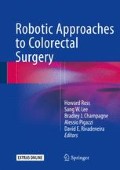Abstract
Robotic surgery requires a complex set of skills not entirely scalable from laparoscopic or open surgery. While some of the robotic maneuvers are more natural than matched traditional laparoscopic steps, the platform, surgical conduct, and planning are foreign to most surgeons. This is evident in the long learning curve to achieve technical proficiency. To facilitate learning, a graded approach has shown promise to efficiently ramp up to safe operations.
Access this chapter
Tax calculation will be finalised at checkout
Purchases are for personal use only
References
Menhadji A, Abdelshehid C, Osann K, et al. Tracking and assessment of technical skills acquisition among urology residents for open, laparoscopic, and robotic skills over 4 years: is there a trend? J Endourol. 2013;27(6):783–9.
Mucksavage P, Kerbl DC, Lee JY. The da Vinci(®) surgical system overcomes innate hand dominance. J Endourol. 2011;25(8):1385–8.
Stolzenburg JU, Qazi HA, Holze S, et al. Evaluating the learning curve of experienced laparoscopic surgeons in robot-assisted radical prostatectomy. J Endourol. 2013;27(1):80–5.
Abboudi H, Khan MS, Aboumarzouk O, et al. Current status of validation for robotic surgery simulators—a systematic review. BJU Int. 2013;111(2):194–205.
Chowriappa AJ, Shi Y, Raza SJ, et al. Development and validation of a composite scoring system for robot-assisted surgical training—the Robotic Skills Assessment Score. J Surg Res. 2013;185(2):561–9.
Stegemann AP, Ahmed K, Syed JR, et al. Fundamental skills of robotic surgery: a multi-institutional randomized controlled trial for validation of a simulation-based curriculum. Urology. 2013;81(4):767–74.
Dulan G, Rege RV, Hogg DC, et al. Developing a comprehensive, proficiency-based training program for robotic surgery. Surgery. 2012;152(3):477–88.
Falcone JL. Don’t touch the sides: a fun and novel system for using Operation(®) for practicing open and robotic surgical skills. Am Surg. 2013;79(5):547–9.
Soliman PT, Iglesias D, Munsell MF, et al. Successful incorporation of robotic surgery into gynecologic oncology fellowship training. Gynecol Oncol. 2013;131(3):730–3.
Thiel DD, Chavez M, Brisson TE. Transition from resident robotic training program to clinical practice: robotic-assisted radical prostatectomy benchmark for perioperative safety. J Laparoendosc Adv Surg Tech A. 2013;23(6):516–20.
Lenihan Jr JP. Navigating credentialing, privileging, and learning curves in robotics with an evidence and experienced-based approach. Clin Obstet Gynecol. 2011;54(3):382–90.
Ben-Or S, Nifong LW, Chitwood Jr WR. Robotic surgical training. Cancer J. 2013;19(2):120–3.
Jimenez-Rodriguez RM, Diaz-Pavon JM, de la Portilla de Juan F, Prendes-Sillero E, Dussort HC, Padillo J. Learning curve for robotic-assisted laparoscopic rectal cancer surgery. Int J Colorectal Dis. 2013;28(6):815–21.
Bokhari MB, Patel CB, Ramos-Valadez DI, Ragupathi M, Haas EM. Learning curve for robotic-assisted laparoscopic colorectal surgery. Surg Endosc. 2011;25(3):855–60.
Kim YW, Lee HM, Kim NK, Min BS, Lee KY. The learning curve for robot-assisted total mesorectal excision for rectal cancer. Surg Laparosc Endosc Percutan Tech. 2012;22(5):400–5.
Akmal Y, Baek JH, McKenzie S, Garcia-Aguilar J, Pigazzi A. Robot-assisted total mesorectal excision: is there a learning curve? Surg Endosc. 2012;26(9):2471–6.
Author information
Authors and Affiliations
Corresponding author
Editor information
Editors and Affiliations
Rights and permissions
Copyright information
© 2015 Springer International Publishing Switzerland
About this chapter
Cite this chapter
McKeown, E., Bastawrous, A.L. (2015). Robotic Training. In: Ross, H., Lee, S., Champagne, B., Pigazzi, A., Rivadeneira, D. (eds) Robotic Approaches to Colorectal Surgery. Springer, Cham. https://doi.org/10.1007/978-3-319-09120-4_21
Download citation
DOI: https://doi.org/10.1007/978-3-319-09120-4_21
Publisher Name: Springer, Cham
Print ISBN: 978-3-319-09119-8
Online ISBN: 978-3-319-09120-4
eBook Packages: MedicineMedicine (R0)

